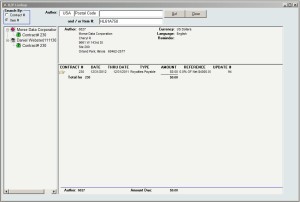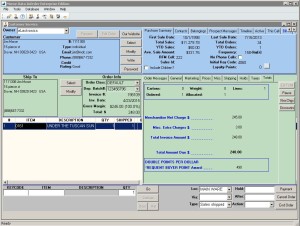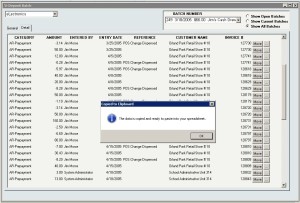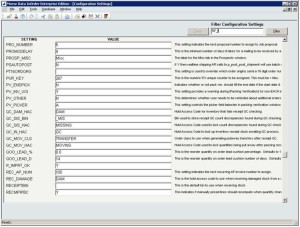InOrder WMS Guides Warehouse Personnel with Receiving
The InOrder RF Receiving functionality is useful when you’re expecting a purchase order to be filled, or when a surprise delivery is made to your dock. After purchase orders are created and printed, they are immediately available for RF receiving. When material is delivered, any RF user (with the appropriate user permissions) may enter or lookup the purchase order with the RF device and begin the receiving process. Multiple RF users may receive items for the same purchase order, which is useful for large purchase orders. RF users may leave their transaction while other RF users continue to receive items on the purchase order, or the user who started the transaction may pause it.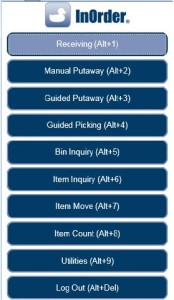 The RF user is guided through the receiving process to first select or lookup a purchase order. The RF User then selects a receiving bin location. Buttons for common receiving bins and hold codes may be configured to represent your specific bins and codes.
The RF user is guided through the receiving process to first select or lookup a purchase order. The RF User then selects a receiving bin location. Buttons for common receiving bins and hold codes may be configured to represent your specific bins and codes.
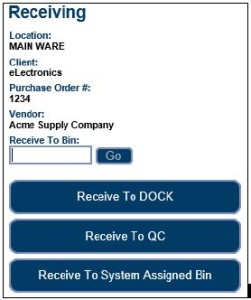 If there are existing, open receipt transactions for the same purchase order (these may be receipt transactions that were paused by the current user or a receipt transaction started by another RF user for a team receiving scenario), the InOrder RF user chooses whether to receive on an existing receipt transaction or start a new receipt transaction.
If there are existing, open receipt transactions for the same purchase order (these may be receipt transactions that were paused by the current user or a receipt transaction started by another RF user for a team receiving scenario), the InOrder RF user chooses whether to receive on an existing receipt transaction or start a new receipt transaction.
The receiving section lists open purchase order line items. This section is useful for receiving small purchase orders (few line items). The open PO line items are presented and may be received one at a time via a button click and confirmation.
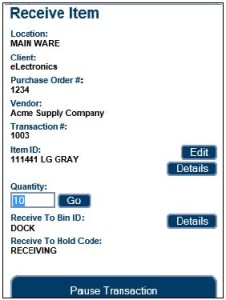 If an item is damaged, a button directs the RF user to a new page to receive the PO line item as damaged.
If an item is damaged, a button directs the RF user to a new page to receive the PO line item as damaged.
Options are also provided to manually receive the purchase order. This option is useful when receiving very large purchase orders with many line items. The item to receive is scanned and the quantity is entered.
A “Receive All” option automatically receives all open line items / quantities for the purchase order. The “View Received Items” button displays a list of line items received for the current purchase order.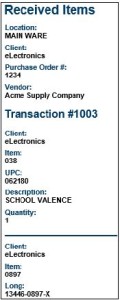 Check out these other great InOrder WMS RF features:
Check out these other great InOrder WMS RF features:
InOrder ERP Quick Tip – Find all Royalty Contracts with the Same Item
When you need to know which royalty contracts have a specific item, simply search Royalty Lookup.
- Click Item # in the Search By area.
- Enter the Item #.
- Click Go.
See InOrder ERP Software at IRCE 2015
In June, the InOrder Team is attending the IRCE, which is the world’s largest eCommerce event. If you’re looking for a leading ERP system with a strong eCommerce platform, stop by our booth (#813) and ask what InOrder can do for you.
If you’re in the Chicago area for the IRCE and you’re looking for good food, check out Tony’s list of places within a 30 minute drive of McCormick Place.
How Your Customer Service Reps Can Help Grow Your Business with InOrder ERP
Does your ERP system provide your customer service reps with the tools they need to give your customers first-rate service and improve your bottom line? Can your reps do this:
- Call customers; enter orders, returns, and quote prices.
- Check loyalty points, subscriptions, order history, and more.
- See what your shoppers looked at. View customers’ website visits, Email that was sent to them, product reviews and other feedback.
- Compose and send a fax, mail, or Email using one of the Microsoft .dot templates to provide a more personalized service experience.
- Offer multiple up, down, circular, diagonal, and cross-selling opportunities over the phone.
InOrder provides your customer service reps with the information they need to engage with all your customers. Loyalty points, which show your appreciation, are available at a glance in Customer Service during order entry. Want to know the customer’s birthday? Check a custom tab. Need to jog your memory about yesterday’s conversation? Check the Timeline. Shipping, taxes, payments, it’s all here, right at your fingertips.
New InOrder ERP Reports to Encourage Customers to Place Orders
Loyalty Programs give customers incentives to buy. They provide benefits for both your business and your customers by generating income and expressing appreciation to your customers. Companies from grocery stores to your local day spa use loyalty award programs to help keep customers coming back, increase sales, and improve customer engagement.
Two new reports, Loyalty Point Expiration Card and Loyalty Account Statements, have been added to the InOrder ERP Loyalty Program Enhancement.
The Loyalty Point Expiration Card is used to generate postcards to send to customers when their loyalty points are nearing expiration.
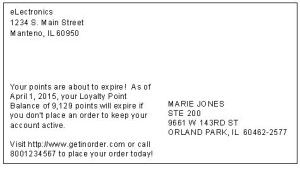 Loyalty Account Statements are generated with the customer’s loyalty point activity and balance.
Loyalty Account Statements are generated with the customer’s loyalty point activity and balance.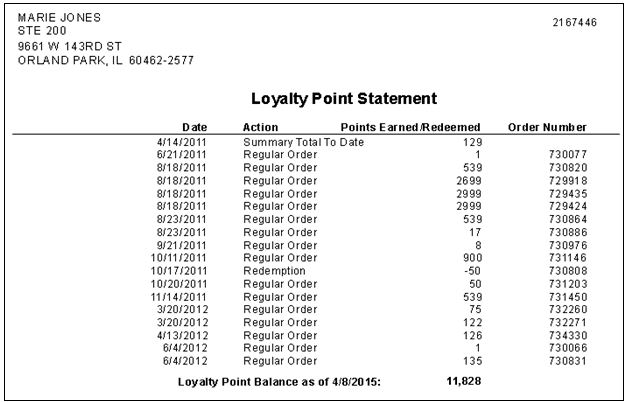
Contact us for more information about the InOrder Loyalty Program Enhancement.
InOrder ERP Quick Tip – Copy Details to Spreadsheet
To allow users to quickly get deposit batch details to a spreadsheet, a copy/paste function is available on the Details tab of the [Deposit Batch] window. To copy the details, use the copy shortcut (CTRL+C) or click the Copy button on the InOrder toolbar.
Extend Your Store Credit to Point of Sale with InOrder ERP
Have you ever seen an old western movie with a customer shopping in the town store, and the customer gets to the register and says “Put it on my account?” They didn’t use debit cards or credit cards, but they were probably customers with good credit and a store credit account.
If you extend credit to your customers, you can bring a piece of that old world charm to your store with InOrder’s Point of Sale module. Simply use the “Pay Later” option, and the receipt prints. For returns, this feature sends the balance to A/R as a credit.
 InOrder tracks the customer’s credit limit for you and only allows this for customers with good credit and enough unused amount on their credit limit to cover the order total. InOrder also makes sure your customer service rep has the appropriate privilege to access this feature. With this feature, you get old world charm and customer service with the latest ERP technology.
InOrder tracks the customer’s credit limit for you and only allows this for customers with good credit and enough unused amount on their credit limit to cover the order total. InOrder also makes sure your customer service rep has the appropriate privilege to access this feature. With this feature, you get old world charm and customer service with the latest ERP technology.
InOrder ERP Stock Drop Transfer Feature Allocates Stock From Nearby Locations
While you might expect ERP systems to backorder or cancel an out of stock item, InOrder can see stock available at a nearby location. If that stock can be brought to the warehouse in time to fill the line item, it is allocated to the order.
 To do this, InOrder generates an inventory transfer to transfer the stock from the remote location back to the warehouse from where the order shipment needs to ship. Personnel at the remote location print the “transfer out” order and pull the stock as soon as possible. The stock is transferred, and the transfer is posted.
To do this, InOrder generates an inventory transfer to transfer the stock from the remote location back to the warehouse from where the order shipment needs to ship. Personnel at the remote location print the “transfer out” order and pull the stock as soon as possible. The stock is transferred, and the transfer is posted.
Stock can be pulled from any designated facility that may have the stock on hand, such as a remote storage location, a point of sale store or merchandise exhibit, or even a consignment location. In some cases there is a risk that the stock is sold to a point of sale customer before it can be transferred. Therefore, InOrder keeps the order from printing in the ship-from warehouse until the transfer is posted to confirm the stock was retrieved.
InOrder ERP Recognizes the New DIM Factors
The major carriers have recently announced billing changes effective January 2015 that use new DIM factors and will increase shipping costs on most packages shipped.
To help more effectively estimate shipping rates, a new “DIM Factor” field is available on ship vias that compute shipping based on Weight Per Carton. If this field is empty or set to 0, the old method of calculating shipping charges is used (simple calculation of merchandise weight + carton weight).
When this field has a value >0, InOrder uses the item dimensions (height, weight, length) to determine appropriate cartons. InOrder calculates the carton’s dimensional weight and compares it to the merchandise weight, and the shipping charges are computed based off the greater of the merchandise weight and the dim weight. Then the shipping charges for each carton in the shipment are summed to calculate the estimated shipping charges for the shipment.
InOrder ERP Quick Tip – Finding a Configuration Setting
One of the many great features about the InOrder ERP system is its versatility. For example, you can tell InOrder which default credit card to use when processing payments, or whether to pause before printing checks. You can even determine when to stop totaling orders for each added line item to improve response time of very large orders.
These functions can be controlled with simple configuration settings that are accessed through an easy to use window from the main menu.
The InOrder ERP system can use hundreds of configuration settings, so the most efficient way to find your setting is to use the Configuration Setting Filter. Simply enter the setting you need to set, click the Filter button, and InOrder finds it for you.
If you’re looking for a configuration setting but you don’t know the exact setting, the Filter can help you find it. For example, if you need to set the default maximum number of batches per shipment that can be assigned to one warehouse picker, you can search for a key word. InOrder will display all the results it finds with that word in the setting or the description.
Simply click the Clear button to start a new search. This filter is also on the Security Class window to help you search on the Privileges tab.






